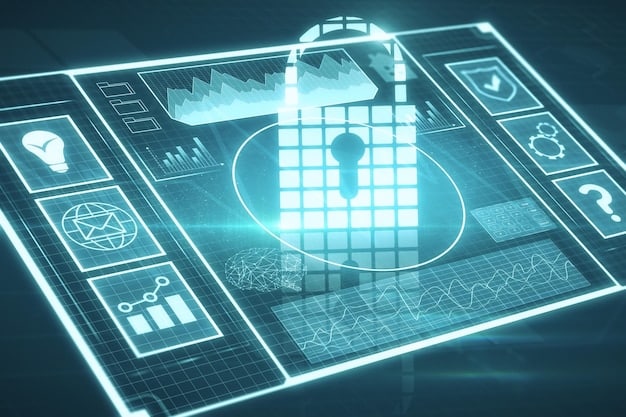Smart Contract Deployment: Your Launch Checklist for Success

Smart contract deployment demands meticulous planning and execution; this checklist ensures developers cover essential aspects from security audits to gas optimization, paving the way for successful and secure launches.
Launching a smart contract deployment can feel like navigating a minefield. This checklist will guide you through each critical step, helping you avoid costly mistakes and ensure a smooth, secure launch.
Understanding Smart Contract Deployment
Before diving into the checklist, understanding the core concepts of smart contract deployment is essential. This involves more than just writing code; it’s about preparing the smart contract for real-world interaction.
Smart contract deployment introduces several layers of complexity to the traditional software development process. Let’s delve into the crucial aspects to ensure a successful launch.
The Importance of Pre-Deployment Testing
Thorough testing is indispensable. It’s your shield against vulnerabilities that can compromise the contract’s integrity and trustworthiness.
Choosing the Right Blockchain Network
Select a blockchain that aligns with your project goals and resources. Each network boasts unique attributes, influencing deployment costs and network capabilities.
- Consider transaction costs to ensure your smart contract can operate effectively without prohibitive fees.
- Evaluate network speed to meet user demand and provide a seamless experience.
- Assess security protocols to safeguard against potential attacks.
Failing to address these fundamental aspects can result in critical oversights during deployment. Diligence in understanding these aspects is key for success.

Essential Pre-Deployment Checklist Items
This checklist focuses on key actions that must be taken before the actual deployment. Following these steps will help to ensure security, efficiency, and readiness.
Prioritizing these checklist items is critical for a successful smart contract deployment. Let’s explore the key elements that every developer should consider.
Code Review and Audits
Engage third-party experts for comprehensive code reviews and audits. Fresh eyes often spot potential issues missed by the development team.
Security Testing and Vulnerability Scans
Conduct robust security testing to identify and rectify vulnerabilities that could be exploited post-deployment.
- Implement static analysis for source code investigation.
- Use dynamic analysis tools to observe the contract’s runtime behavior.
- Perform penetration testing to simulate real-world attack vectors.
Ignoring these crucial steps can put your smart contract at significant risk, as vulnerabilities can be costly to fix and damage trust and reputations.
Security Considerations During Smart Contract Deployment
Security considerations need to be taken seriously when starting your smart contract deployment. Security mechanisms help to identify vulnerabilities and prevent attacks. Implementations should align with practices.
Robust security measures are non-negotiable for any smart contract deployment. Developers must prioritize security, by integrating multiple layers of protection to mitigate risks.
Access Control Mechanisms
Implement well-defined access control policies to restrict unauthorized interactions with the smart contract. Enforce the principle of least privilege to ensure that only authorized users or contracts can modify the smart contract’s state or access sensitive data.
Data Validation and Sanitization
Always validate input data to prevent common vulnerabilities like integer overflow or underflow, and ensure that data is properly sanitized before processing. Such checks help prevent unintended behavior and protect the contract from malicious inputs.

Gas Optimization Techniques for Smart Contracts
Optimizing gas consumption is a key factor in ensuring your smart contract’s cost-effectiveness. Understanding gas limits and optimization techniques is paramount.
Deploying smart contracts efficiently is crucial for keeping costs under control. Gas optimization techniques can significantly impact the performance and accessibility of your smart contracts.
Minimizing Storage Usage
Efficient data storage reduces gas costs. Storing repetitive data on-chain can quickly escalate expenses so consider minimizing the storage overhead.
Batch Operations
Batching operations can optimize gas usage. Grouping transactions together reduces the overall gas cost.
- Consolidate multiple reads into a single call.
- Bundle multiple writes using techniques like arrays.
- Reduce loops that iterate over large datasets.
A gas-optimized contract not only reduces operational costs, but it also promotes scalability and efficiency on the blockchain network.
Testing and Validation Steps for Smart Contracts
Testing and validation are not just steps, but are critical in smart contract deployment. These guarantee contracts perform, and they also respond as programmed.
Comprehensive testing and validation are essential for ensuring the reliability and functionality of your smart contracts. Thorough testing mitigates the risk of unexpected behavior or failures once the contract is live.
Unit Testing
Conduct unit testing to validate individual functions and modules within the smart contract, and confirm contract functions as intended. Automated testing facilitates rigorous validation.
Integration Testing
Perform integration testing to ensure that different components of our smart contract interact correctly, and to verify the behavior of the software.
Post-Deployment Monitoring and Maintenance
Post-deployment activities are crucial for long-term success. Monitoring contract performance and ongoing maintenance are vital for stability.
The deployment phase may signal the project’s “go-live,” but smart contract care requires diligence and engagement. Continuous monitoring and maintenance ensure that your contracts remain secure, functional, and efficient over time.
Monitoring Contract Performance
Implementing real-time monitoring to track key metrics is vital for identifying potential issues early.
Regular Security Audits
Schedule regular security audits to address emerging threats and ensure ongoing adherence to best practices.
- Evaluate changes through re-audits to maintain security.
- Follow security alerts from the crypto community.
- Implement proactive changes to protect against new vulnerabilities.
Continuous care prolongs the life of your smart contracts, ensuring they remain functional, and secure amid the changing blockchain landscape.
| Key Aspect | Brief Description |
|---|---|
| ✅ Security Audits | Comprehensive code review to identify vulnerabilities. |
| ⚙️ Gas Optimization | Reducing transaction costs by optimizing code. |
| 🧪 Testing and Validation | Thorough testing to ensure reliability. |
| 📊 Monitoring | Continuous oversight to identify issues promptly. |
Frequently Asked Questions
▼
A smart contract audit is a comprehensive review of the code by a third-party expert to identify vulnerabilities, bugs, and inefficiencies. It helps ensure the contract is secure and functions as intended.
▼
Gas optimization is crucial because it reduces the cost of executing smart contracts. Lower gas usage translates to lower transaction fees, making the contract more accessible and sustainable for users.
▼
Security audits should be performed before deploying a smart contract and regularly thereafter, especially after making significant updates. This ensures ongoing protection against vulnerabilities.
▼
Common vulnerabilities include reentrancy attacks, integer overflow/underflow, timestamp dependence, and denial-of-service attacks. Awareness of these risks helps in implementing preventive measures.
▼
Tools like Etherescan, Tenderly, and Blocknative help monitor smart contract performance by providing real-time data on transactions, gas usage, and potential security issues. These insights are invaluable for maintenance.
Conclusion
By adhering to this comprehensive checklist, developers can navigate the complexities of smart contract deployment with greater confidence. From prioritizing security audits and gas optimization to rigorous testing and continuous monitoring, each step is vital for ensuring a smooth, secure, and efficient launch. Embracing these practices will not only protect your project but also contribute to the overall integrity and trustworthiness of the blockchain ecosystem.





